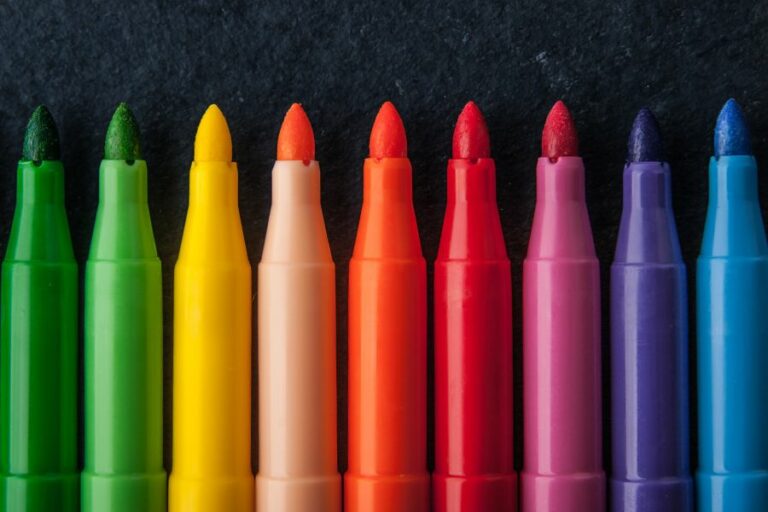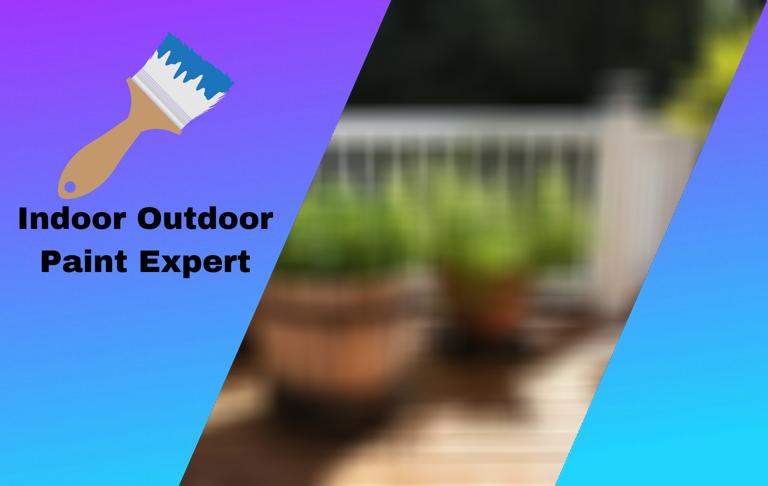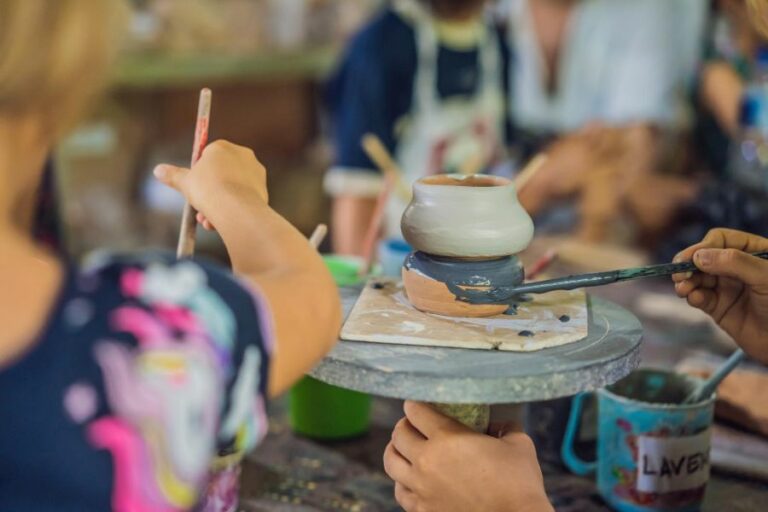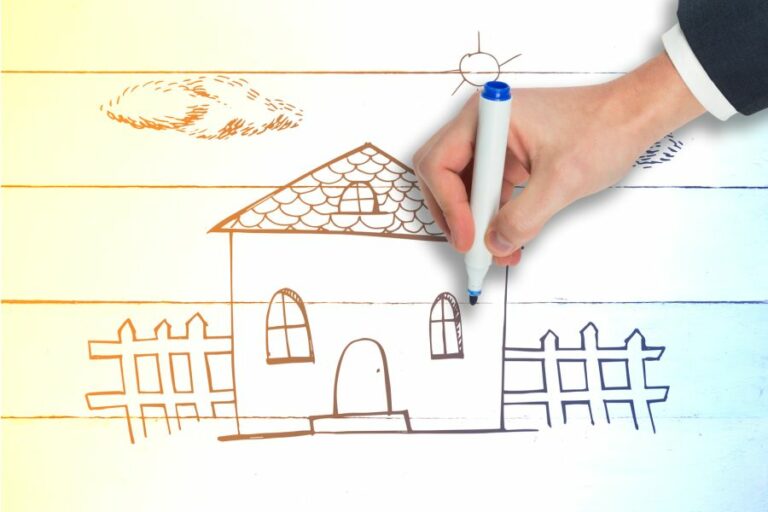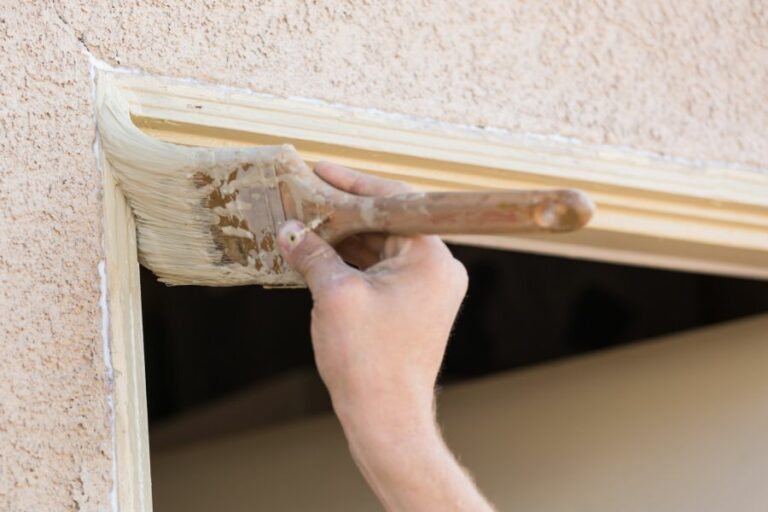Top Outdoor Furniture Paints to Refresh Your Space
Welcome to our latest post on the best outdoor furniture paint! This guide highlights the top paints available today and helps you navigate the options and choose your outdoor oasis.
With our expert tips and recommendations, you can transform your patio or deck into a vibrant, weather-resistant sanctuary your family and friends will love. So, don’t let your furniture fade into the background – dive in now and discover how to make your outdoor space shine with the perfect paint.
Best outdoor furniture paint:
We will discuss the best outdoor furniture paint options, including spray paint, acrylic paint, and oil-based paint, with top recommendations like Rust-Oleum Painter’s Touch, Krylon Fusion All-In-One, Valspar Duramax, and Behr Premium Plus. It also provides tips for painting outdoor furniture, such as surface preparation, proper application techniques, choosing suitable weather conditions, and allowing enough drying time. Following these guidelines can help create a beautiful, durable finish for outdoor furniture.

Discover the ideal paint to refresh your outdoor space! We’ve handpicked the finest selections for durability, ease of use, and style. Learn about time-tested favorites, hidden gems, and expert tips for a flawless finish. Transform your backyard oasis today!
Contents
- 1 Top-Quality Outdoor Furniture Paint Solutions
- 2 What Type of Paint Should You Utilize for Outdoor Furniture?
- 3 What is the Optimal Paint Sheen for Exterior Furniture?
- 4 What is the most durable and long-lasting exterior paint for wooden surfaces?
- 5 What is the Optimal Paint Finish for Exterior Metal Furniture?
- 6 Which Kind of Paint is Most Effective for Exterior Wood Applications?
- 7 Determining the Superior Method: Should You Spray or Paint Outdoor Furniture?
Top-Quality Outdoor Furniture Paint Solutions
A well-maintained garden or patio is incomplete without the perfect outdoor furniture. However, finding the right paint to refresh and protect your outdoor furniture can be challenging.
We will discuss the best outdoor furniture paint options and provide various tips and tricks to make the painting process easier and more efficient.
• Types of Outdoor Furniture Paint
1. Spray Paint
Spray paint is an excellent option for outdoor furniture as it provides an even coat and is easy to apply. It dries quickly and comes in various finishes like matte, semi-gloss, and high gloss.
Several brands specialize in outdoor furniture spray paints, including Rust-Oleum and Krylon.
Recommendations
- Rust-Oleum Painter’s Touch 2X Ultra Cover: This paint is known for its 2X coverage, allowing you to achieve full coverage with fewer coats. It’s available in various colors and finishes.
- Krylon Fusion All-In-One: This paint bonds well with various surfaces, including wood, metal, and plastic. It has excellent UV resistance and dries quickly.
2. Acrylic Paint
Acrylic paint is another popular choice for outdoor furniture. It is water-based, easy to clean up, and durable, with strong adhesion to various surfaces. It is available in various colors and finishes and is suitable for painting furniture made from wood, metal, plastic, and more.
Recommendations
- Valspar Duramax Exterior Paint: This paint is known for its high-quality finish on various surfaces. It is fade-resistant and can endure harsh weather conditions.
- Behr Premium Plus Exterior Paint: This paint is an excellent choice for wooden furniture as it protects against the elements while retaining the wood’s natural beauty.
3. Oil-Based Paint
Oil-based paints are durable and provide a high-quality finish. They are more resistant to water and weather conditions than water-based paints, which makes them an ideal choice for outdoor furniture in high-moisture areas.
However, oil-based paints require longer drying times and emit more fumes, so some may have better options.
Recommendations
- Rust-Oleum Protective Enamel Paint: This oil-based paint provides excellent coverage and durability. It suits various surfaces, including metal, wood, and concrete.
- Benjamin Moore Aura Exterior Paint: This paint is known for its long-lasting finish and resistance to fading, cracking, and peeling.
• Tips for Painting Outdoor Furniture
Now that we’ve covered the best outdoor furniture paint options let’s look at some tips that will help make the painting process smoother and more efficient.
– Prepping the Surface
Before painting any outdoor furniture, it is crucial to prep the surface to ensure proper paint adhesion. Cleaning the furniture using a mild detergent and water mixture to remove dirt and debris. If there is any old paint or rust, use a wire brush or sandpaper to remove it.
Once the surface is clean and dry, apply a primer if required. The primer will seal the surface and provide a smooth base for the paint to adhere to.
– Proper Application Techniques
Using the right application technique is essential for a flawless paint job. When using spray paint, hold the can consistently from the surface, apply thin, even coats, and keep the can moving to avoid drips and runs.
For brush application, use a high-quality brush, and avoid over-brushing to prevent visible brush strokes. Alternatively, you can also use a paint roller for larger surfaces.
– Weather Conditions
Always choose a day with suitable weather conditions to paint your outdoor furniture. Avoid painting on rainy, humid, or windy days, as this can affect the paint’s adhesion and drying time. Opt for when the temperature is between 50 to 85 degrees Fahrenheit and low humidity levels.
– Proper Drying Time
Allow the paint to dry when the manufacturer recommends before applying additional coats or using the furniture. This is essential for ensuring the paint’s durability and preventing the paint from peeling or chipping prematurely.
• Conclusion
Choosing the right paint for outdoor furniture is essential for its aesthetics and durability. Consider factors like the type of material, the paint finish, and the weather conditions in your area when selecting a paint for your project.
Following the proper prepping and application techniques, you can transform worn-out outdoor furniture into a beautiful and long-lasting addition to your outdoor space.
Brand | Type | Colors | Durability |
|---|---|---|---|
Rust-Oleum | Spray Paint | Various | High |
Krylon | Spray Paint | Various | High |
Behr | Exterior Latex Paint | Various | High |
Benjamin Moore | Exterior Latex Paint | Various | High |
Sherwin Williams | Exterior Latex Paint | Various | High |
What Type of Paint Should You Utilize for Outdoor Furniture?
When painting outdoor furniture, choosing the right kind of paint is crucial. The paint must withstand various weather conditions and wear and tear from usage.
In this comprehensive guide, we will explore the different types of paints suitable for outdoor furniture, their pros and cons, and some tips on how to paint your furniture for the best results.
• Acrylic Latex Paint
One of the most popular and recommended options for painting outdoor furniture is acrylic latex paint. This water-based paint offers excellent durability, weather resistance, and easy application.
– Pros of Acrylic Latex Paint
- Water-based, making it easy to clean up with soap and water.
- Excellent durability and weather resistance to ensure the paint remains vibrant and doesn’t chip or peel.
- Low levels of toxic fumes, making it more environmentally friendly than other paint options.
- Fast-drying, usually within a couple of hours.
- Wide range of colors and finishes available.
– Cons of Acrylic Latex Paint
- Requires proper surface preparation, such as sanding and priming, to ensure good adhesion
- Generally more expensive than oil-based paints
• Oil-Based Paint
Another option for painting outdoor furniture is oil-based paint. These paints provide a more durable and long-lasting finish but have disadvantages compared to acrylic latex paints.
– Pros of Oil-Based Paint
- Superior durability and resistance to wear and tear.
- It can be applied directly to metal surfaces without needing a primer.
- Offers a smoother finish, with fewer brush marks visible.
- Longer drying time, making it easier to correct mistakes and achieve an even finish.
– Cons of Oil-Based Paint
- Contains more harmful chemicals than water-based paints, resulting in stronger fumes and a higher environmental impact.
- Cleanup requires chemicals like mineral spirits or turpentine.
- Longer drying time can be a disadvantage if you hurry to complete your project.
• Spray Paint
Spray paint is a popular choice for outdoor furniture thanks to its ease of use and quick-drying properties. Most spray paints are acrylic or enamel-based, providing a durable and weather-resistant finish.
– Pros of Spray Paint
- Easy to apply, even for beginners, provided you follow the proper technique.
- Quick drying, usually within a matter of minutes.
- A simple and effective way to cover hard-to-reach areas or intricate details on your furniture.
- Available in various colors and finishes, including specialized paints for metal or plastic surfaces.
– Cons of Spray Paint
- It can result in an uneven finish without the proper technique.
- Limited control over paint application compared to using a brush or roller.
- Paint fumes can be an issue if not used in a well-ventilated area.
• Tips for Painting Outdoor Furniture
Regardless of the type of paint you choose, there are some key tips to follow when painting your outdoor furniture:
- Clean your furniture: Before starting any painting project, ensure the surface is clean and free of dirt, dust, or other contaminants that may prevent proper paint adhesion.
- Always use a primer: Applying a primer before painting helps improve paint adhesion and gives you a smoother finish. Choose a primer compatible with the paint you are using and designed for outdoor use. For instance, oil-based primers should only be used with oil-based paints.
- Sand your furniture: Lightly sanding your furniture with fine-grit sandpaper (about 180-220 grit) will help the paint adhere better and smooth away any rough patches or imperfections on the surface.
- Apply multiple thin coats: For the best finish, it’s essential to apply multiple thin coats of paint rather than one thick coat. This will result in a smoother appearance and reduce the risk of drips and runs.
- Allow enough drying time: Follow the manufacturer’s recommendations on drying time between coats and give your furniture ample time to dry fully before using or exposing it to the elements.
- Use a sealer or topcoat: Applying a clear sealer or topcoat can further enhance the durability of your outdoor furniture, providing extra protection against damage from weather and regular use.
In conclusion, acrylic latex paint is the most recommended option for painting outdoor furniture, thanks to its durability, ease of application, and environmentally-friendly properties. However, depending on your preferences and specific needs, oil-based and spray paint can also be suitable.
Following the tips above and choosing the right paint for your project, you can transform your outdoor furniture and gain lasting results.
Type of Paint | Description |
|---|---|
Exterior latex paint | Water-based paint that is durable, easy to clean, and provides a long-lasting finish. |
Oil-based paint | Quick and easy to apply, it provides a smooth finish and is available in a variety of colors and finishes. |
Spray paint | Water-based paint that dries quickly, is weather-resistant and can be used to create detailed designs. |
Acrylic paint | Water-based paint that dries quickly is weather-resistant and can be used to create detailed designs. |
What is the Optimal Paint Sheen for Exterior Furniture?
Outdoor furniture is exposed to the elements, so choosing the right paint sheen is essential for aesthetic and practical reasons. While there’s no one-size-fits-all answer, understanding the different paint sheens and their characteristics can help you make an informed decision.
We will guide you through the ideal paint sheens for various types of outdoor furniture and factors to consider when selecting the best finish.
• Understanding Paint Sheens
Before diving into specific recommendations, it’s important to understand the differences between paint sheens. The most common sheens include flat, matte, eggshell, satin, semi-gloss, and gloss. Generally, sheens with higher gloss levels tend to be more durable but also show more imperfections on the surface.
Lower sheens are more forgiving of surface imperfections but may not be as durable or resilient against the elements.
– Flat and Matte Paints
Flat and matte paints provide a non-reflective finish, which helps to hide surface imperfections. However, they are less durable than higher gloss paints and may not be well-suited for outdoor furniture with a lot of wear and tear.
– Eggshell and Satin Paints
Eggshell and satin paints are a step up in durability and gloss. They provide a slightly reflective finish that is more resistant to scuffs, marks, and weathering than flat or matte paints. Satin paints, in particular, are a common choice for outdoor furniture due to their balance of durability and appearance.
– Semi-Gloss and Gloss Paints
Semi-gloss and gloss paints provide a highly reflective finish that is easy to clean and offers excellent resistance to moisture, stains, and the elements. However, they also tend to show surface imperfections more easily than lower-sheen paints, which can be a drawback on outdoor furniture with rough surfaces or visible wear.
• Factors to Consider When Choosing a Paint Sheen
Below are some factors to keep in mind as you determine the best paint sheen for your outdoor furniture:
– Material of the Furniture
Different materials require different paint sheens to provide optimum protection and appearance. For instance, metal furniture benefits from higher gloss paint, offering better protection against rust and other weather-related damage.
In contrast, wooden furniture may look more natural with a lower sheen, such as an eggshell or satin finish.
– Weather Conditions
The local weather conditions should significantly influence your choice of paint sheen. If your outdoor furniture is exposed to frequent rain, humidity, or direct sunlight, selecting a higher gloss paint can provide better protection against the elements.
On the other hand, if your furniture is under a covered area or in a milder climate, a lower sheen paint may be all that is necessary.
– Cleaning and Maintenance
When selecting a paint sheen for outdoor furniture, consider the maintenance you’re willing to commit to, as certain sheens require more frequent cleaning to maintain their appearance.
For instance, furniture painted with a high-gloss finish may need to be cleaned more often, as dirt and dust are more noticeable on shiny surfaces. However, the upside is that higher gloss paints are generally easier to clean than their lower sheen counterparts.
– Aesthetic Preferences
Personal preferences play a role in selecting the ideal paint sheen for outdoor furniture. Some people prefer the rich, deep colors and subtle texture of lower-sheen paints, while others appreciate higher gloss paints’ smooth, polished look.
Strike a balance between practicality and appearance to ensure you’re happy with the result.
• Recommendations for Different Types of Outdoor Furniture
Based on the factors discussed above, here are some general sheen recommendations for various outdoor furniture materials:
– Wooden Furniture
For wooden outdoor furniture, I recommend eggshell or satin finish paints. These sheens provide enough durability to protect against the elements without giving the wood an overly artificial, shiny appearance.
– Metal Furniture
Opt for semi-gloss or gloss finish paints for outdoor metal furniture. These higher-sheen paints provide optimum protection against rust, chipping, and other damage caused by exposure to the elements.
– Plastic Furniture
Plastic outdoor furniture can benefit from a satin or semi-gloss finish. These sheens offer adequate protection against fading and weathering while maintaining a clean, attractive appearance.
– Wicker and Rattan Furniture
Eggshell or satin finish paints are ideal for wicker or rattan outdoor furniture, balancing protection and natural appearance. Their slight sheen adds durability without detracting from the furniture’s characteristic texture.
In conclusion, selecting the best paint sheen for outdoor furniture depends on the material, weather conditions, maintenance preferences, and aesthetic taste.
By carefully considering these factors and referring to the above recommendations, you can make an informed decision and ensure your outdoor furniture looks beautiful and withstands the test of time.
Sheen Type | Benefits |
|---|---|
Flat or Matte | Low reflection, hides imperfections, elegant finish |
Eggshell or Satin | Balanced sheen, easy to clean, durable |
Semi-gloss | High durability, easy to clean, shiny appearance |
Gloss | Highest durability, easy to clean, highly reflective |
What is the most durable and long-lasting exterior paint for wooden surfaces?
As an experienced professional in the painting industry, I have seen homeowners’ constant quest for the longest-lasting exterior paint for wood. Wood, a natural material, is susceptible to wear and tear from weather elements, insects, and other factors.
Therefore, using the right paint to maximize its durability and maintain its aesthetic appeal is essential. We will explore various exterior paints that offer longevity and recommend the ones that stand out in durability and protection.
• Acrylic Latex Paint: A Popular Choice
For good reasons, acrylic latex paint is one of the most popular options for painting wooden exteriors. It provides several benefits that make it an excellent choice for long-lasting protection:
- Durability: When applied correctly, acrylic latex paint can last 10 to 15 years on exterior wood surfaces, making it one of the longest-lasting options. Its flexibility allows it to expand and contract with the wood, reducing the chances of cracking and peeling.
- Fade Resistance: Acrylic latex paint is highly resistant to fading from sunlight, ensuring that the color remains vibrant for an extended period.
- Moisture Resistance: Water-based, acrylic latex paint does not trap moisture within the wood, preventing rot, warping, and other moisture-related issues.
- Ease of Application: Acrylic latex paint can be easily applied using brushes, rollers, or sprayers, making it suitable for professional and DIY applications.
- Environmentally Friendly: Acrylic latex paint has lower levels of volatile organic compounds (VOCs) than oil-based paints, reducing its impact on the environment and indoor air quality.
Based on these benefits, acrylic latex paint is highly recommended for exterior wood surfaces, offering an ideal balance of longevity and protection.
• Oil-Based Paint: A Durable Alternative
Oil-based paint is another excellent option for wooden exteriors, known for its durability and rich finish. While it may not be as popular as acrylic latex paint due to its higher VOC content and longer drying time, oil-based paint offers certain advantages that make it worth considering:
- Longevity: Oil-based paint is highly durable, with a lifespan of up to 15 years when applied correctly on exterior wood surfaces.
- Resistance to Scratches and Wear: Oil-based paint forms a hard and durable surface resistant to scratches and other forms of wear, making it suitable for high-traffic areas.
- Smooth Finish: Oil-based paint tends to self-level during the application, resulting in a smoother and more uniform finish than acrylic latex paint.
However, it is essential to remember that oil-based paint takes longer to dry and requires more elaborate preparation and clean-up, which may only be suitable for some projects. Nonetheless, oil-based paint remains a reliable and long-lasting option for exterior wood surfaces.
• Elastomeric Paint: Unparalleled Protection
Elastomeric paint is a high-performance coating designed to provide superior protection and durability. While it may be more expensive and less common than acrylic latex and oil-based paints, elastomeric paint has unique properties that make it an excellent choice for long-lasting exterior wood protection:
- Exceptional Durability: Elastomeric paint has an estimated lifespan of up to 20 years when applied correctly on exterior wood surfaces, making it one of the longest-lasting options available.
- Crack Resistance: The highly elastic nature of elastomeric paint allows it to bridge and seal small cracks in the wood, preventing further damage and extending the paint job’s life.
- Waterproofing: Elastomeric paint forms a watertight seal on the wood surface, protecting it from moisture-related issues such as rot and warping.
Due to its unparalleled protection and durability, elastomeric paint is highly recommended for exterior wood surfaces, especially in areas with extreme weather conditions or a history of wood-related issues.
• Choosing the Right Paint: Factors to Consider
Apart from the type of paint, certain factors can influence the durability and performance of the exterior paint on wood:
- Surface Preparation: Proper surface preparation, such as cleaning, scraping, and sanding, is crucial for ensuring the paint adheres well to the wood and lasts longer.
- Priming: Applying a suitable primer before painting can improve the paint’s adhesion, color retention, and overall durability.
- Number of Coats: Applying multiple coats of paint, following the recommended drying time between coats, can extend the paint job’s life.
- Paint Quality: Investing in high-quality paint from reputable brands can significantly impact the lifespan and appearance of the paint job. Cheap, low-quality paints may offer different protection and durability than higher-end options.
• In Conclusion
Based on my experience, acrylic latex paint and elastomeric paint are the best options for ensuring long-lasting protection and durability on exterior wood surfaces. While oil-based paint is also a durable alternative, it has a few drawbacks that may only make it suitable for some projects.
Remember to consider factors such as surface preparation, priming, the number of coats, and paint quality when choosing the right paint for your wooden exteriors, as this will directly influence the lifespan and appearance of the paint job.
You can enjoy the beautiful and long-lasting results of a well-painted wooden exterior for years with proper care and attention to detail.
What is the Optimal Paint Finish for Exterior Metal Furniture?
Outdoor metal furniture is designed to withstand the elements, but the finish can wear down over time, leading to rust and discoloration. Choosing the appropriate paint finish is crucial to maintain the appearance and longevity of your metal furniture.
We will discuss the best paint finishes for outdoor metal furniture and provide recommendations based on our experience.
• The Importance of Paint Finish for Outdoor Metal Furniture
The right paint finish does more than just enhance the appearance of your furniture. It also protects against corrosion, weathering, and UV damage. When selecting a paint finish for your outdoor metal furniture, consider the following factors:
- Durability: The paint finish should withstand wear and tear, providing long-lasting protection against rust and other forms of corrosion.
- Color Retention: High-quality paint finishes should maintain their vibrant color and sheen, even when exposed to harsh weather conditions.
- Ease of Application: Some paint finishes might require a professional application or specialized equipment, while others can be easily applied using a brush, roller, or spray can.
Considering these factors, let’s explore the top paint finishes for outdoor metal furniture.
• Powder Coating: The Gold Standard for Metal Furniture Finish
Regarding the best finish for outdoor metal furniture, powder coating is the gold standard. It is a process in which a dry powder is electrostatically applied to a metal surface and then cured under heat, creating a strong, durable film. Powder coating has several advantages over traditional liquid paint:
– Unmatched Durability
Powder-coated finishes are known for their exceptional durability, as they are resistant to chipping, scratching, fading, and corrosion. This makes them an ideal choice for outdoor furniture, where constant exposure to the elements can quickly take a toll on the finish.
– UV and Weather Resistance
Powder-coated finishes provide excellent protection against the sun’s harmful UV rays, which can cause paint to fade over time. This UV resistance, combined with the inherent durability of the powder coating, ensures that your outdoor furniture will retain its vibrant color and sheen for years to come.
– Environmentally Friendly
Compared to traditional liquid paint, powder coatings contain minimal volatile organic compounds (VOCs), making them an environmentally friendly option. Moreover, the excess powder can be easily recovered and reused, reducing waste.
– Wide Range of Colors and Textures
Powder coating offers many color and texture options, from glossy smooth finishes to textured or matte appearances. This versatility makes finding the perfect finish for your outdoor metal furniture easy.
On the downside, powder coating can be more expensive than traditional paint finishes and requires a professional application. However, considering the durability and longevity of powder-coated finishes, the investment is often worthwhile.
• High-Quality Spray Paint: A Cost-Effective Alternative
High-quality spray paint is a viable option for those looking for a cost-effective alternative to powder coating. When choosing spray paint for outdoor metal furniture, consider these points:
- Look for paints specifically designed for outdoor use on metal surfaces, as they contain additives that offer protection against rust and corrosion.
- Opt for enamel or acrylic paint, which provides a durable, long-lasting finish.
- Choose paint with built-in UV protection to keep the color vibrant over time.
- Follow the manufacturer’s instructions for surface preparation, application, and drying time to achieve the best results.
Although spray paint may not offer the same level of durability as powder coating, it is a cost-effective solution for those looking to revamp their outdoor metal furniture without breaking the bank.
• In Conclusion
In our experience, powder coating is the best paint finish for outdoor metal furniture thanks to its durability, weather resistance, and color retention. However, high-quality spray paint can also produce great results for those seeking a more budget-friendly alternative.
No matter which paints finish you choose, proper surface preparation and maintenance are crucial to ensure your outdoor metal furniture remains protected and looks its best for years. Regularly inspect your furniture for signs of wear or damage, and address these issues promptly to prevent further deterioration.
You can enjoy outdoor metal furniture for many seasons with the right paint finish and maintenance routine.
Paint Finish | Qualities | Pros | Cons |
|---|---|---|---|
Powder Coating | Durable, long-lasting, diverse color options | Resistant to chipping, scratching, fading, and weather conditions | Requires professional application |
Enamel Paint | Glossy, hard, durable finish | Good resistance to weather and corrosion | Longer drying time, may require multiple coats |
Epoxy Paint | Hard, durable, adhesive | Resistant to rust and corrosion, weatherproof | May yellow under sunlight, requires careful surface preparation |
Acrylic Latex Paint | Water-based, flexible | Less likely to crack and peel, quick drying | Less durable than other options, may require frequent touch-ups |
Which Kind of Paint is Most Effective for Exterior Wood Applications?
Painting outdoor wood is an important task that helps maintain the life and appearance of wooden structures like a deck, fence, or furniture. Choosing the right paint is essential to ensure the wood is well protected from the elements while enhancing the look of your outdoor space.
We will discuss the paints best suited for outdoor wooden surfaces and tips for perfect finishing.
• Types of Outdoor Wood Paints
– Latex paint
Latex paint, also known as water-based paint, is popular for outdoor wood due to its durability and ease of application. It forms a flexible, breathable layer on the wood, which allows moisture to escape, preventing peeling and cracking. One of the significant advantages of latex paint is that it dries quickly and has a lower chance of mildew growth.
Expert recommendation: For a long-lasting, low-maintenance finish, consider using high-quality acrylic latex paint designed for exterior use. This kind of paint offers superior UV protection and excellent adhesion to the wood.
– Oil-based paint
Oil-based paint forms a hard, protective layer on the wooden surface, making it an excellent option for outdoor furniture or structures that require a robust and durable finish. However, unlike latex paint, oil-based paint takes longer to dry and requires more frequent reapplications.
Expert recommendation: Opt for high-quality alkyd paint with good UV and water resistance if you prefer oil-based paint for your outdoor wood. This type of paint provides excellent coverage and durability, despite the longer drying time.
– Solid Stain
Solid stains are similar to paint in terms of opacity and coverage, but they penetrate the wood’s surface instead of forming a layer on top. This quality of solid stains makes them less prone to peeling and chipping, ensuring a longer-lasting finish. Solid stains come in various colors, and the final result resembles paint.
Expert recommendation: Choose a high-quality solid stain designed explicitly for outdoor wood. Ensure it has UV inhibitors and water repellents to provide maximum protection against the elements.
• Tips for Painting Outdoor Wood
– Preparation
Preparing the wooden surface is essential for achieving a perfect finish. Follow these steps to prepare your outdoor wood:
- Clean the wood using a brush, mild detergent, and water to remove dirt, mildew, and loose paint. Ensure the surface is smooth and free of debris.
- Patch any holes or cracks with an exterior wood filler and sand the area until smooth.
- If the wood is damp or has a high moisture content, allow it to dry for at least 48 hours before applying the paint or stain.
- Apply a coat of exterior wood primer to ensure proper paint adhesion and prevent wood tannins from bleeding through the paint.
– Application
After the wood surface is clean and primed, follow these best practices for applying the paint or stain:
- Use a high-quality brush or roller designed for outdoor wood when applying paint or stain.
- Stir the paint or stain well before applying it to ensure an even color distribution.
- Apply the paint or stain in thin, even layers, allowing each coat to dry according to the manufacturer’s instructions. It generally requires a minimum of two coats for adequate coverage and protection.
- Sand the wood surface lightly between coats with fine-grit sandpaper to ensure a smooth finish.
– Maintenance
Regular maintenance of your outdoor wood structures enhances their appearance and prolongs their life. Follow these tips to ensure the longevity of your paint or stain job:
- Inspect the wood surfaces yearly, checking for peeling, fading, or other signs of wear.
- Touch up any areas with damaged paint, and consider applying a fresh coat every few years.
- Clean the wood surfaces regularly with mild detergent and water to remove dirt and grime.
- Exposure to sunlight can cause paint or stain to fade over time. Occasionally move outdoor furniture or structures to more shaded areas to reduce sun exposure and maintain color vibrancy.
• In Conclusion
When painting outdoor wood, remember that using the right type of paint or stain and following the proper application techniques can make all the difference in ensuring the durability and longevity of your outdoor wooden surfaces.
Choose a high-quality latex paint or solid stain specifically designed for exterior wood, and follow the preparation and application guidelines to achieve a perfect, long-lasting finish. Keep your outdoor wood well-maintained to remain visually appealing and protected against the elements.
Type of Paint | Advantages | Disadvantages |
|---|---|---|
Acrylic Latex Paint | Water-based, easy to clean up, quick drying, resistant to cracking and peeling, excellent color retention | Not as durable as oil-based paints |
Oil-Based Paint | Durable, long-lasting, superior adhesion to wood surfaces, better leveling (smooth finish) | Longer drying time, harder to clean up, higher VOC content (strong odor), prone to yellowing over time |
Semi-Transparent Stain | Allows the natural wood grain to show through, provides a subtle color, penetrates the wood to protect it from moisture and UV damage | Less protection than solid stains or paints, needs to be reapplied more frequently |
Solid Stain | Hides the natural wood grain, which may peel or chip over time | Less protection than solid stains or paints needs to be reapplied more frequently |
Determining the Superior Method: Should You Spray or Paint Outdoor Furniture?
Deciding between spray paint or traditional brush-on paint can be challenging when it comes to updating or protecting outdoor furniture. By comparing the advantages and disadvantages of each method, we will determine the most suitable option for your outdoor furniture restoration project.
• Spray Painting: The Fast and Efficient Solution
Spray painting is popular for those who want to save time and effort on their outdoor furniture project. Here, we discuss the benefits and drawbacks of spray paint.
– Benefits of Spray Painting
- Speed: Spray paint dries quickly, allowing multiple coats to be applied within a shorter time frame than brush painting.
- Smooth finish: Spray paint provides an even and smoother finish on outdoor furniture, as there is no contact between the paintbrush and the surface.
- Ability to cover hard-to-reach areas: With spray paint, it is easier to access and paint tight spaces and intricate designs that brushes cannot reach.
- Range of finishes: Spray paint is available in a wide variety of textures and finishes, allowing for more options to customize the look of your outdoor furniture.
– Drawbacks of Spray Painting
- Potential for overspray: Spray paint can easily drift onto nearby surfaces, so proper masking and protection of the surrounding area are essential.
- Cost: The cost of spray paint can be higher than traditional paint, especially if you require multiple cans to finish the job.
- Limited color selection: Although many finishes exist, not all color choices are available in spray paint form.
• Brush Painting: The Traditional and Precise Approach
Brush painting is the conventional method of painting outdoor furniture and offers some unique advantages. Here, we look at both the benefits and drawbacks of brush painting.
– Benefits of Brush Painting
- Control: Painting with a brush allows for greater control over the paint application, ensuring even coverage and thickness.
- Cost-effective: Brush painting tends to be more economical than spray painting, as you can purchase paint in larger quantities.
- Wide color selection: With brush painting, you can choose from a limitless array of colors, including custom mixes to match existing furniture or fixtures.
- Eco-friendly: Brush painting is generally considered more environmentally friendly than spray painting, as it produces less waste and uses fewer resources.
– Drawbacks of Brush Painting
- Time-consuming: Brush painting requires more time than spray painting, as each coat needs to dry completely before the next one is applied.
- Uneven finish: Brush painting may provide a smoother finish than spray painting due to the possibility of brush strokes or uneven paint distribution.
- Difficulty in reaching tight spaces: Painting intricate details and tight crevices with a brush may be more challenging than using spray paint.
• Factors to Consider When Choosing Spray or Brush Painting
To determine the best method for your outdoor furniture project, consider the following factors:
- Type of furniture: The material and level of detail in your outdoor furniture will affect your choice between spray and brush painting. Delicate, intricate designs might benefit from spray painting, while simple, large pieces could be more suited to brush painting.
- Budget: If you are working within a tight budget, brush painting may be the more cost-effective than spray paint.
- Skill level: If you have little painting experience and want to complete your project quickly, spray painting may be the better choice. On the other hand, if you have more experience and are confident in your painting abilities, brush painting could provide a more controlled and precise finish.
- Weather conditions: Spray painting requires dry and windless conditions to minimize the risk of overspray and uneven coverage. In contrast, brush painting can be accomplished even in less-than-ideal weather conditions.
• Conclusion: Choosing the Right Method for Your Outdoor Furniture Project
Ultimately, deciding between spray painting and brush painting your outdoor furniture comes down to your preferences, budget, and comfort level. Both methods have advantages and drawbacks, but with careful planning and consideration, you can achieve a stunning transformation regardless of which approach you select.
I recommend experimenting with spray painting and brush painting on small, inexpensive pieces of furniture to determine which method works best for you. Doing so ensures that your larger, more valuable pieces receive the perfect combination of speed, control, and quality in their restoration process. Happy painting!

